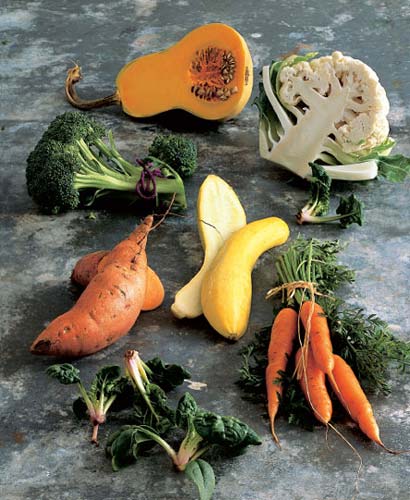Double Delicious (30 page)

Portion and Package the Purees
- 1.
Measure the purees into 2-cup portions (sometimes I make 4-cup portions, depending on the recipe) and package in small zipper-lock plastic bags if you plan to use the puree within a few days (or in freezer bags for longer storage). Many people have told me they use ice-cube trays. Whatever works for you is great! From time to time I’ll use a muffin tin, but baggies work well for me most often. - 2.
Using a permanent marker, label each bag with the type and amount of puree and the date. For example, “ ½ cup squash, 6/27/10.” - 3.
Refrigerate purees that will be used in the next couple of days; freeze the rest. I use plastic storage bins in both the fridge and the freezer to hold the bagged purees. The bags stay more organized, and it’s easier to keep track of which ones to use first.
4

Cook
Now that you have your kitchen and pantry stocked, you’re ready to use the recipes.
- 1.
Scan the recipes and choose the purees you need. Always use older purees first (check the date). - 2.
Thaw bags of frozen puree in a bowl of hot tap water. - 3.
Snip the corner of the bag with scissors to squeeze out the puree for your recipe.

Vegetable Purees:
How To

BROCCOLI
Prep:
Cut into florets.
Cook:
Steam for 6 to 7 minutes. Florets should be tender but still bright green. (If they’re an olive green, they’re overcooked.)
Puree:
Use a food processor or blender for about 2 minutes. May need a few teaspoons of water, for a smooth, creamy texture.

CARROTS
Prep:
Peel, trim the ends, and cut into 3-inch chunks.
Cook:
Steam for 10 to 12 minutes.
Puree:
Use a food processor or blender for about 2 minutes, with a few teaspoons of water, for a smooth texture.

BUTTERNUT SQUASH
Prep:
Do not peel. Cut off stem, cut squash in half lengthwise and scrape out the seeds.
Cook:
Roast the halves on a baking sheet, flesh-side down, in a 400°F oven for 45 to 50 minutes.
Puree:
Scoop out the flesh and puree in a food processor or blender for about 2 minutes.

CAULIFLOWER
Prep:
Cut off florets and discard the core.
Cook:
Steam for 8 to 10 minutes.
Puree:
Use a food processor or blender for about 2 minutes, with a few teaspoons of water if needed for a smooth, creamy texture.

SWEET POTATOES
Prep:
Do not peel. Cut into quarters if steaming. Leave whole if roasting.
Cook:
Steam for 40 to 45 minutes. Roast in a 400°F oven for 50 to 60 minutes.
Puree:
Scoop out the flesh and puree in a food processor or blender.

YELLOW SQUASH
Prep:
Trim off the ends and cut into 1-inch pieces.
Cook:
Steam for 6 to 8 minutes.
Puree:
Use a food processor or blender for about 2 minutes, until smooth.

SPINACH
Prep:
No prep at all for baby spinach. For mature spinach, fold leaves in half lengthwise with the stem outside, then strip the stem off the leaf.
Cook:
Steam for 30 to 40 seconds, or cook in a skillet with 1 tablespoon water for about 90 seconds, or just until wilted.
Puree:
Use a food processor or blender for about 2 minutes, until smooth and creamy.
S
o many people are concerned, rightfully so, with fats and oils in their food. It’s such a confusing subject that I asked Lisa Sasson to weigh in: “Fat improves the taste and aroma of many foods. It’s also an essential nutrient that provides many health benefits. In fact, we can’t live without it! Adding a little fat—such as salad dressing or drizzling a little oil on your vegetables—helps your body absorb some of the vital nutrients. So a fat-free or very low-fat diet should NOT be a health goal.
Instead, the focus should be on consuming moderate amounts of healthy fats and to enjoy them instead of feeling guilty!” That sounds great to me, especially because I love the flavor of olive oil and enjoy full-fat cheese from time to time. I’m glad I can enjoy them without a lot of worry. Instead, I pay attention to my portion sizes.
Basically, to be a smarter food shopper, you should know about three types of fat: saturated fats, unsaturated fats, and trans fats.
